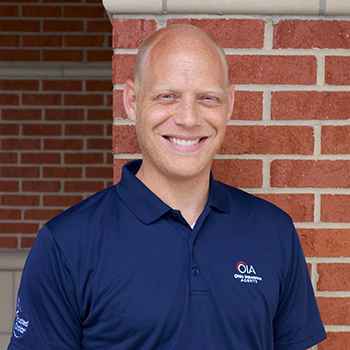
Hi! My name is Adam. I am a data analytics professional.
Can you picture me?
Short sleeved, starched, white-collared shirt with a pocket protector and an epic Star Wars action figure collection still in pristine boxes on the shelves in my living room. . . you got it?
|
Editor’s note: Here’s Adam. He’s a total data
|
I joined OIA last summer without any insurance industry knowledge, but I have learned a lot in the last twelve months, both generally and specific to technology.
My mission was simply stated: “Make OIA a formidable name in the insurance data and business consulting space.”
You’ve probably noticed that we have been working diligently to build out products to help agents with valuation, perpetuation, and using business insights to assist them in growing their agency.
As a part of trying to familiarize myself with the industry and independent agents, I met with agencies owners, talked to industry professionals, and read as many articles as I could get my hands on.
Through all of this it became very evident to me that there are TONS of opportunities to modernize the insurance agent channel using technology.
One thing I kept thinking to myself was, “how has no one outside of OIA seen the opportunity for agents to harness the power of data?”
You know that moment, at a bar, when you think you’ve come up with a brilliant product idea that you know no one else has discovered?

Right then your buddy — who incidentally hates your happiness — Googles your idea and it turns out there are about a million other people building that exact thing in China, cheaper and faster.
As I continued digging and discussing, what was more apparent to me was that EVERYBODY in the insurance industry DID realize the exact opportunity that I ‘discovered’, and they are actively trying to exploit it.
“Insurtech is the next great disruptor/enabler!”
If you are in the industry, you see it everywhere.
Still I wondered to myself, “If the insurance technology and data space is already this crowded, how have none of these deep pockets figured out how to unlock this thing?!”
Actually, if you know me at all, you’d know I said this out loud more than once to anyone who would listen.
Two main groups in the insurtech space
The way I think about the insurtech movement, rightly or wrongly, is by bucketing it into two groups:
-
Those who are trying to minimize the insurance process to “vending-machine transactions” to disrupt and replace incumbent players.
-
Those who are working to empower the existing channels and improve the overall experience of those working in, and with, the industry.
In the first group, there are technology companies, and some carriers, trying to create direct-to-consumer products that liken buying insurance to a “vending-machine transaction.”
Consider, for a minute, the implications of buying the wrong insurance.
In this industry, settling for “What’s the worst that could happen?” could mean severe, life-long financial consequences. It is the reason consultation is required when buying insurance.
Apply that same logic to transaction-based consumer interactions that inspire the insurtech movement, like mobile check deposit, and it’s obvious there’s a clear difference.
The worst that can happen in that situation is a check deposited into the wrong account which can promptly be fixed.
On the flip side, there are organizations that are trying to enhance or improve the existing channel by deploying technology enhancements to make their own experience more efficient and, thus, the consumer’s experience a more positive one.
OIA falls squarely into this second camp.
Major players
So, let’s look at all the parties involved in the insurtech movement.
You’ll see that when I say ‘everybody’ has their hands in an insurtech bucket, I mean everybody.
-
CARRIERS: Almost all the major carriers have programs to collect data and automate tasks, making it easier on them and their agents.
-
INSURANCE START-UPS: You can’t sling a dead cat without hitting one.
There are tons of them, and a lot are in niche insurance spaces like, micro-insurance, behavioral insurance, and one of my favorites — peer-to-peer insurance.
-
STATE INSURANCE ASSOCIATIONS: In addition to Ohio, other state insurance associations are interested in participating in the insurtech movement to better the existing channel.
-
AGENGY MANAGEMENT SYSTEMS: Ugh. This one is the worst. In any other industry, these ‘big players’ would be considered dinosaurs and their legacy systems would have been traded out for cheaper open-sourced options by now.
Do you want to make a billion dollars? Just invent an agency management system that is subscription-based, open-source, affordable, and user friendly. The bar is super low!
Some folks are catching a whiff of this and newer companies are entering the space because they see the opportunity to improve on these cumbersome, bureaucratic, closed-down, costly products.
-
INSURANCE CONSULTING FIRMS: There are a few well-known insurance consulting firms that have been doing self-reported data analysis for years using survey data.
-
LARGE SOPHISTICATED AGENCIES: Finally, there are some sophisticated agencies who are forward-thinking about technology, but they generally skew very large, as it takes a lot of resources to deploy these technologies.
So, you might ask, “Adam, now that we have seen a lot of the players within this marketplace, why would I bet on OIA?”
The answer is simple, no one else in that list is solely focused on the collective independent agent channel’s success.
Everyone else has a dog in the fight, and their name is “John Q. Shareholder”.
We are here to support the whole pack, only looking to grow the wealth of the channel from within each agency.
With the network of agents and carrier partners that OIA has built, we have a better chance of lifting and shifting the independent agent channel forward.
We have a considerable competitive advantage over the other participants using our force multiplier…
TRUST.
Either way, I favor the success of the channel enhancers, rather than the ‘channel destroyers’, as I like to refer to them.
I view this all this as healthy competition.
More competition in this space will only lead to a continually raised bar, which benefits everyone involved.
There are plenty of fish in the sea and there’s plenty of business to go around.
Let’s stay focused on the fact that this is an industry that is in desperate need of modernization and it’s finally getting the attention it deserves.
Want to learn more about OIA's Valuation Services?
Have an opinion about the insurtech movement?






